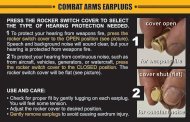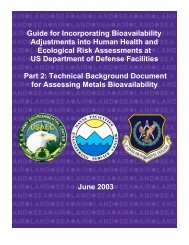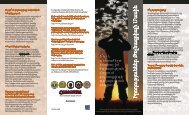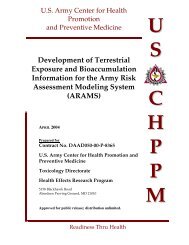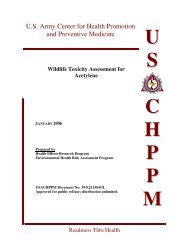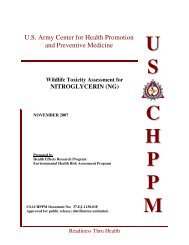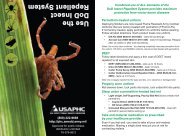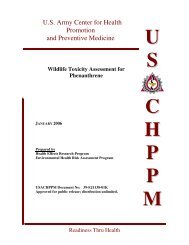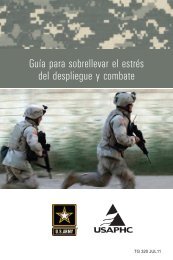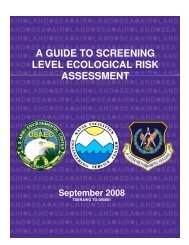Tri-Service Remedial Project Manager's Guide for Ecological Risk ...
Tri-Service Remedial Project Manager's Guide for Ecological Risk ...
Tri-Service Remedial Project Manager's Guide for Ecological Risk ...
You also want an ePaper? Increase the reach of your titles
YUMPU automatically turns print PDFs into web optimized ePapers that Google loves.
ERA because data generated will be used to help estimate risk. Growth, mortality, andreproductive endpoints at the population level are generally the focus of the ecological effectscharacterization, unless T&E species are impacted. When T&E species are potentiallyimpacted, the level of protection is <strong>for</strong> individual members of the population. Examples ofecological effects include:l Behavioral effects.l Lethal effects.l Population changes.l Community changes.l Ecosystem structural or functional changes.l Bioaccumulation and biomagnification of chemicals.l Indirect effects such as loss of habitat or food source.5HIHUHQFH/RFDWLRQA Reference Location is an uncontaminated site used <strong>for</strong> comparison to contaminatedsites in environmental monitoring (often incorrectly referred to as a control). Selectingappropriate reference locations is difficult but very important to accurately evaluate theecological effects in an ERA. The reference location should be similar in media, habitat andgeography, but not impacted by contamination from the site. Reference locations should bereflective of typical background and anthropogenic concentrations that are not attributable tothe site of concern. For example, a reference site <strong>for</strong> a location with contaminated soil shouldhave a similar soil type with similar vegetation and wildlife habitat. Undisturbed areas on thesite (not subjected to contamination) may serve this purpose. However, off-site locations maybe required, especially <strong>for</strong> aquatic habitats.When choosing a reference location, the riskassessor should consult with people knowledgeablewith characteristics of the area and seek in<strong>for</strong>mationfrom organizations that have local records.In<strong>for</strong>mation may be obtained from organizations,such as those listed in Appendix F, and fromInstallation records.Rule of Thumb #12When choosing a referencelocation, make use of readilyavailable scientific resourcesthat have local site in<strong>for</strong>mation.6WUHVVRU5HVSRQVH3URILOHData on “cause and effect” of the contaminant (stressor) at the site need to be <strong>for</strong>mattedinto a Stressor/Response Profile. Each Measurement Endpoint should, in theory, have its ownprofile. In practice, profile data may be hard to find or difficult to generate.A stressor/response profile may include:l No Observed Adverse Effects Concentration or Level (NOAEC or NOAEL).l Lowest Observed Adverse Effects Concentration or Level (LOAEC or LOAEL).l Lethal Concentration 50 (LC 50 ), Lethal Dose 50 (LD 50 ), Effective Concentration 50 (EC 50 ).l The percentile of the population community or system affected versus exposuredose.29



